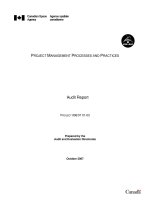Project management tools and techiques
Bạn đang xem bản rút gọn của tài liệu. Xem và tải ngay bản đầy đủ của tài liệu tại đây (1.9 MB, 134 trang )
Project Management Tools &
Techniques
Susan W. Carey
Workshop Objectives
•
•
•
•
•
•
Recognize project management terminology
Explain roles and responsibilities for key players
Develop a project proposal
Construct a work breakdown structure
Identify tools for tracking and controlling a project
Recognize the importance of a formal closeout
INTRODUCTION TO
PROJECT MANAGEMENT
Module Objectives
•
•
•
•
•
Recite project management terminology
Describe the characteristics of a project
Distinguish between a project and sub projects
Identify the benefits of project management
Define the roles and responsibilities of the various
stakeholders
• Determine what it takes for successful project
management
BASICS OF PROJECT MANAGEMENT
Definition of a Project
• A series of inter-related and sequenced
activities, managed by a single individual,
designed and organized to accomplish a
specific goal, within a limited timeframe,
frequently with specific budgetary
requirements
Remember:
Characteristics of Projects
•
•
•
•
Undertaken at all levels
Single person or thousands
Duration could be weeks or years
Single unit or entire organization
Projects are critical to the realization of the
performing organization’s business strategy
because projects are a means by which
strategy is implemented.
Characteristics of Projects
•
•
•
•
•
•
Are unique
Consume time
Cost money
Requires people
Contain risks
Sequence of tasks
Types of Projects
• Developing a new product or service
• Effecting a change in structure, staffing, or style of an
organization
• Designing a new transportation vehicle
• Developing or acquiring a new or modified information system
• Constructing or renovating a building or facility
• Building a water system for a community in a developing
country
• Running a campaign for political office
• Implementing a new or improved business process or
procedure
Subprojects
• Based on project process such as a single phase
(e.g. design)
• According to human resource skill
requirements (e.g. plumbing)
• By major deliverable (e.g. training)
Project Structure
Project
Sub-Project A
Work
Work
Packages
Work
Packages
Work
Packages
Packages
Sub-Project B
Work
Work
Packages
Work
Packages
Work
Packages
Work
Packages
Packages
Sub-Project C
Work
Work
Packages
Work
Packages
Work
Packages
Packages
Definition of Project Management
• Taking knowledge, skills, tools, and techniques,
applying those to project activities to satisfy
the business need for which the project was
undertaken
Benefits of Project Management
•
•
•
•
•
•
•
Do more with less
Flexible framework
Clear expectations
Progress is monitored
Lessons learned
Do it right the first time
Less frustration
Project Phases / Project Life Cycle
• Involve a degree of uncertainty
• Divide the project into several phases
– Improve control
– Provide links to operation
• Phases are referred to as the “project life
cycle”
Characteristics of the Project Life
Cycle
• Defines the beginning and end of a project
• Includes the following phases:
–
–
–
–
Initiation
Planning
Execution
Closeout
What’s Your Organization Type?
• Functional?
• Matrix?
• Projectized?
Project Characteristics by
Organization Type
Matrix
Project
Characteristics by
Org Type
Funtional
Projectized
Weak
Balanced
Strong
Project Manager's
Authority
Little or none
Limited
Low to
Moderate
Moderate to
High
High to Almost Total
Resource Availability
Little or none
Limited
Low to
Moderate
Moderate to
High
High to Almost Total
Who controls the
budget?
Functional
Manager
Functional
Manager
Mixed
Project Manager
Project Manager
Project Manager's
Role
Part time
Part time
Full time
Full time
Full time
Project Mgmt Admin
Staff
Part time
Part time
Part time
Full time
Full time
Challenges in a Matrix Environment
•
•
•
•
•
•
•
Lack of PM’s formal authority (biggest challenge)
Resource management
Dual reporting relationship
Potential for duplication of effort
Unclear roles and responsibilities
Greater potential for conflict
Lack of accountability
Types of Authority
•
•
•
•
•
Formal
Purse-string
Bureaucratic
Technical
Charismatic
Key Players
• Project sponsor
– Ensures the project meets the business needs
– Provides funding
– Approves key deliverables
– Assists in issues resolution and change
management
Project Sponsor Challenges
• Micro managing project sponsor
• The invisible project sponsor
Key Players
• Project manager
– Assembles the project team
– Assigns tasks and activities
– Monitors progress, risk, issues
– Manages the scope
– Delivers on time and within budget
– Ensures project documentation is prepared
Key Players
• Stakeholders
– Individuals or organizations that are actively
involved in the project or whose interests may be
positively or negatively affected as a result of the
project
– May exert influence over the project and its results
Key Players
• Project leader
– Responsible for a subproject
– Ensures technical aspects are delivered
– Monitors progress, risk, issues
– Manages the scope and the change management
process
– Delivers on time and within budget
– Communicates status to project manager









